2 Global Threats to Undersea Communication Cables (Nichols & Beckman)
Abbreviations
AAG – Asia-America Gateway Cable System
ACO – Aerospace Cybersecurity Operations, KSU graduate program
Army Corps – US Department of Defense, US Army Corps of Engineers
BOEM – US Department of the Interior, Bureau of Ocean Energy Management
DWDM – Leverages Dense Wavelength Division Multiplexing
FCC – Proponent Agency: Federal Communications Commission
FERC – Federal Energy Regulatory Commission
LTE – Line Terminal Equipment
NOAA – US Department of Commerce, National Oceanic and Atmospheric Administration
NPE – Network Protection Equipment
PFE -Power Feed Equipment
POP – Point of Presence
SCC – Submarine Communications Cables
SCS – South China Seas
SLTE – Submarine Line Terminal Equipment
Student Learning Objectives
Chapter 2 is an introductory chapter covering Submarine Communication Cables, their global purpose, function, architecture, specific threats, and vulnerabilities to their existence. They are extremely important in international communications and the national critical infrastructure of several large countries. Chapter three will look at various risk assessment models for Guam and its military implications for US defense.
Some of the material in this chapter has been presented/condensed at /from Kansas State University Faculty Day 2024 (Nichols, Diebold, & Johnson, Risk Analysis of submarine cables in the Western Pacific, 2024) and C2SR Research Symposium (Nichols, Diebold, & & Johnson, Suas/UAS Cyber Terror Implications & Cyber-Navigation Threats & CHINESE UAS INTELLIGENCE CAPABILITIES & Impending Invasion Of TAIWAN, 2022) and graduate Aerospace Cyber Operations (ACO) 680 /682. Explicit written permissions of coauthors received.
Submarine Communications Cables (SCC)
A submarine communications cable (SCC) is a cable laid on the seabed between land-based stations to carry telecommunication signals across stretches of ocean and sea. The first submarine communications cables were laid beginning in the 1850s. They carried telegraphy traffic, establishing the first instant telecommunications links between continents, such as the first transatlantic telegraph cable, which became operational on August 16, 1858. (WIKI, 2025) See Figure 2-1 First Transcontinental Cable (1858)
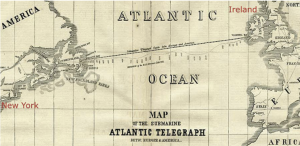
Submarine cables first connected all the world’s continents (except Antarctica) when Java was connected to Darwin, Northern Territory, Australia, in 1871, in anticipation of the completion of the Australian Overland Telegraph Line in 1872, connecting to Adelaide, South Australia, and thence to the rest of Australia. (WIKI, 2025)
Subsequent generations of cables carried telephone traffic, then data communications traffic. These early cables used copper wires in their cores, but modern cables use optical fiber technology to carry digital data, which includes telephone, Internet, and private data traffic. Modern cables are typically about 25 mm (1 in) in diameter and weigh around 1.4 tons per kilometer (2.5 short tons per mile; 2.2 long tons per mile) for the deep-sea sections, which comprise the majority of the run, although larger and heavier cables are used for shallow-water sections near shore. (WIKI, 2025) See Figure 2-2 for SCC composition and construction.
Figure 2-2 SCC Composition and Construction Source: (WIKI, 2025)
A cross-section of the shore-end of a modern submarine communications cable. 1 – Polyethylene 2 – Mylar tape 3 – Stranded steel wires 4 – Aluminum water barrier 5 – Polycarbonate 6 – Copper or aluminum tube 7 – Petroleum jelly 8 – Optical fibers
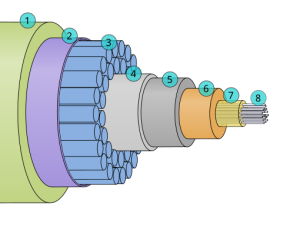
What is a submarine (underwater) cable?
Submarine cables have several features. Fiber optic cables connect countries everywhere in the world, often thousands of miles long, and are able to transmit data from point to point rapidly. Two or more landing points connect them. They use repeaters for signal boosts placed every ~100km. They are made of a mixture of plastic, steel wiring, copper, and nylon, often covered in silicon (Figure 2-2). Figure 2-3 shows the SCC to a landing point. Notice the lack of security from access vehicles, animals, and human threats.
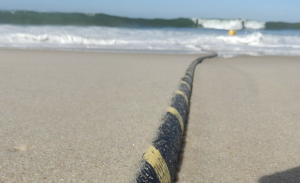
How Does an Undersea Cable Work
SCC uses Leverages Dense Wavelength Division Multiplexing (DWDM). These are multiple wavelengths operating at hundreds of gigabits per second (fastest is Google’s Virginia to France Dunant cable at ~250 terabits per second). Repeaters, aka optical amplifiers, amplify the wavelengths. Landing stations house the networking equipment that distributes data traffic, powers the cables, and controls their operations. Submarine Line Terminal Equipment (SLTE) can be installed at the landing station or inland. Power Feed Equipment (PFE) is usually installed at the landing station.
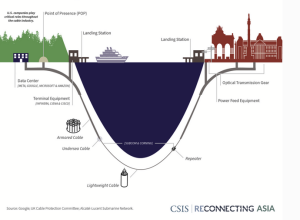
Cable Faults
Undersea cables are subject to Earth’s movements, volcanoes, changing ocean conditions, and intentional sabotage. Figures 2-5 and 2-6 show reported Cable Faults. In this chapter, we are concerned with only intentional cuttings or sabotage (generally by state actors).
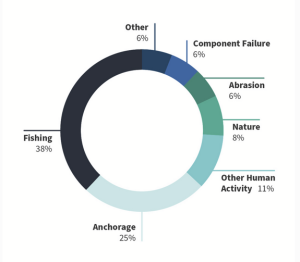
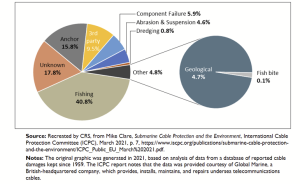
Landing Points
The two main functions associated with Landing Points are: 1) Cable Landing Station – Only required in the event the submarine cable requires an extensive amount of power for its amplifiers or repeaters. Cables may only land at a Cable Termination Station. 2) Cable Termination Station – The point where a submarine cable connects to the land-based infrastructure, often the same place as the landing station.
Landing Station Overview includes various telecommunications equipment: Network Protection Equipment (NPE), Line Terminal Equipment (LTE), Wavelength termination equipment, Transmission line amplifiers, Circuitry for supervisory functions (cable performance, fault detection, location), and Terrestrial City Point of Presence (modems, digital leased lines, multi-protocol routers). For more details on Landing station communication and architectures, see (Nichols, Diebold, & Johnson, Risk Analysis of submarine cables in the Western Pacific, 2024)
Commercial Use Of Undersea Cables
Cables were traditionally owned by telecom firms that joined together to share costs. Today, large companies like Facebook, Google, and Amazon are investing in private projects. Western consortia have responded to Chinese attempts at underbidding projects for undersea cables, making sure China cannot tap into these for mass surveillance. China and Russia continue to tap into SCC for information exploitation. (Nichols, Diebold, & Johnson, Risk Analysis of submarine cables in the Western Pacific, 2024)
Worldwide Undersea Cables
Some properties of SCC worldwide:
- Over 400 cables (486 reported to Congress, some estimates at over 530) are in operation today
- Some are shorter than 50 miles, some are as long as 10,000 miles in the Pacific
- Often have multiple landing access points in different countries (1,306 total landing stations worldwide)
- Antarctica is the only continent not connected through undersea cables (Nichols, Diebold, & Johnson, Risk Analysis of submarine cables in the Western Pacific, 2024)
Undersea Cable Services in the Western Pacific
Our concern in this chapter is with Undersea Cable Services in the Western Pacific. Undersea cables carry roughly 95% of all traffic between island nations in the Pacific. Satellites account for about .37%. Approximately $10 trillion in financial transactions are transmitted on cables daily on ~26 Cable Systems. The private sector almost entirely controls planning, production, deployment, and maintenance: 1) Alcatel Submarine Networks (France); 2) SubCom (US); 3) NEC (Japan); and 4) Huawei Marine Networks (China). (Nichols, Diebold, & Johnson, Risk Analysis of submarine cables in the Western Pacific, 2024) See details in Figures 2-7 to 2-9. (Nichols, Diebold, & Johnson, Risk Analysis of submarine cables in the Western Pacific, 2024)
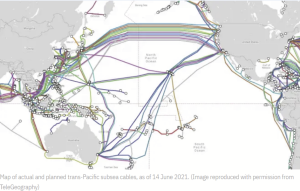
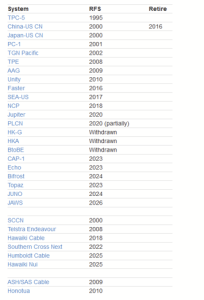
Figure 2-9 International Traffic in KTB Source: (hawaii.edu/news/, 2019) Reproduced with permission courtesy of Subtel.
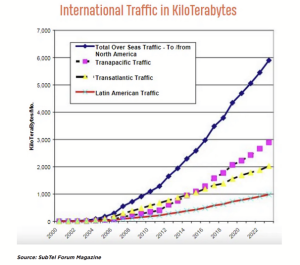
Undersea Cable Mission Support
Submarine cables provide the primary means of connectivity – voice, data, and Internet – between the United States and the rest of the world, as well as connectivity between the mainland United States and consumers in Alaska, Hawaii, Guam, American Samoa, the Northern Mariana Islands, Puerto Rico, and the US Virgin Islands. The Federal Communications Commission (FCC) and various agencies are involved in the oversight of the submarine cables and/or other undersea activities that may impact submarine cable infrastructure. The FCC’s International Bureau grants licenses authorizing cable landing license applicants to own and operate submarine cables and associated landing stations in the United States. To wit:
- Proponent Agency: Federal Communications Commission (FCC) (FCC, 2025)
Other Agencies:
- US Department of the Interior, Bureau of Ocean Energy Management (BOEM)
- Federal Energy Regulatory Commission (FERC)
- US Department of Commerce, National Oceanic and Atmospheric Administration (NOAA)
- US Department of Defense, US Army Corps of Engineers (Army Corps)
Figure 2-7 shows the importance of communications in the South China Seas (SCS) – the most volatile theater in the Western Pacific. Figure 2-10 indicates that trillions of bytes of financial, commercial, personal, and military information traverse the SCS theater. Taiwan is in the center of the theater and represents a hot spot and thorn in the side of China. Satellites may be technological marvels, but they are not in the same communication boat as SCCs. So let us look at the international thorn in the SCS.
THREATS – CHINESE
Huawei Marine represents a primary threat to global communications. Why?
- Subsidiary of Huawei (Known control by the Chinese Government)
- Sold to Heng Tong Optic-Electric, a Chinese fiber and cable manufacturer
- The director and founder is a CCP government official
- Featured on the US Entity List
- Won praise from the Chinese Government as being a model of “civil-military integration” and, in a press release, “offers powerful support for the modernization of our country’s national defense.”
- Built or repaired almost ¼ of the world’s 400+ submarine cables
- Participated in about 90 projects worldwide and built 50,361km of cables
- Threats – The Big 3: China Telecom, China Unicom, and China Mobile. See Figure 2-12 in SCS. (R.K..Nichols, Johnson, & Diebold, 2024)
- Control 98.5% of China’s international bandwidth
- Ownership stake in 31 cables deployed in 2021. See Figure 2-10 and Figure 2-11.
Source: (Nichols, Diebold, & Johnson, Risk Analysis of submarine cables in the Western Pacific, 2024)
Figure 2-10 shows the strategic importance of Chinese influence on SCC via connections to the Chinese Mainland.
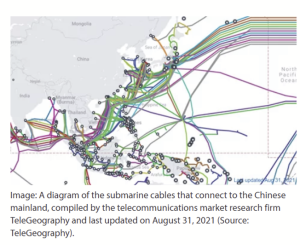
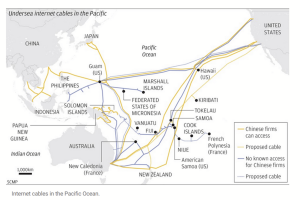
China owns a significant portion of the SCC network. They control the Internet and could shut down most of the communications to all surrounding countries. (High threat) They also have links to military assets through their outposts. See Figure 2-12.
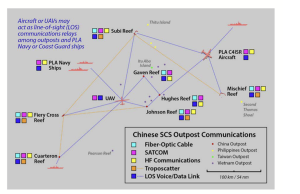 Figure 2-12 Threats – Redundancy in the South China Sea for China, cropped 600ppi Source: (Nichols, Diebold, & Johnson, Risk Analysis of submarine cables in the Western Pacific, 2024)
Figure 2-12 Threats – Redundancy in the South China Sea for China, cropped 600ppi Source: (Nichols, Diebold, & Johnson, Risk Analysis of submarine cables in the Western Pacific, 2024)
China is not alone as a state actor with bad intentions. Russia recently joined the party and assisted China in the Baltic Sea. (Nichols R., Chapter 14 Maritime Cybersecurity, 2020)
THREATS – RUSSIAN
Threats – Russian Submarines!
Russian Losharik
The ‘Losharik’ submarine was launched in 2003 and is Russia’s only submarine designed specifically for research, rescue, and special military operations up to 6,000 meters in depth. In comparison, ordinary military submarines can only operate in depths of up to 100-200 meters and are limited to firing projectiles from a depth of 50 meters.
One of the missions of the Losharik submarine was to monitor the seafloor, as well as to tap into or sever underwater telecommunication cables that transmit information about military ships’ movements, as well as their intercommunications and information transfers. Losharik’s main mission these days is extreme depth shelf exploration for potential further mineral extraction.
The ‘Losharik’ is a nuclear-powered submarine with an atomic reactor that can operate deep underwater. It carries zero weapons on board; it is instead equipped with a claw manipulator and a hydrostatic tube, cameras for monitoring underwater situations, and a bedrock cleaning system. It has a maximum speed of 30 knots (roughly 34.5 mph or 55 km/h). See Figures 2-13 and 2-14.
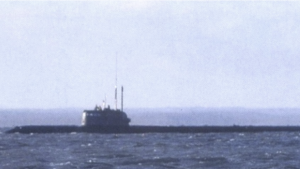
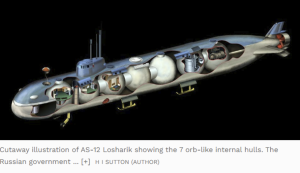
THREATS – CHINESE SHIPS – YANTAR
As recently as February 17, 2023, a Chinese fishing vessel and a cargo ship were found to be responsible for cutting two undersea cables that connect Taiwan’s Matsu island. The cost imposed is roughly $329,000 to repair and as high as $600,000+. Broken wires have been reported more than 20 times in the last 5 years between Taiwan and Matsu. China’s PLAN has built a robust capability for undersea cable maintenance and development that is not publicly disclosed but assessed by open-source reporting and is employed throughout the Spratly Islands. China established the Submarine Cable Communication Technology Research Center at the Wuhan PLA Naval University of Engineering to supervise military undersea cable construction and maintenance.
Two ships, the East Cable 885 and South Cable 233, are responsible for maintaining undersea cables for the PLAN, and presumably can perform sabotage or espionage.
The maritime militia and coast guard also likely have this capability.
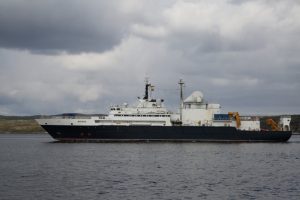
VULNERABILITIES
Key vulnerabilities to be exploited in the SCS are Landing Stations and Underwater Cables. Sometimes figures are better than words. See Figures 2-16 to 2-21 for a breakdown.
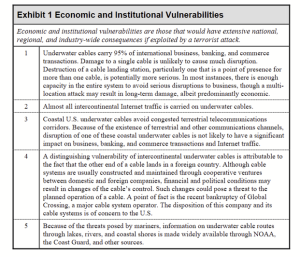
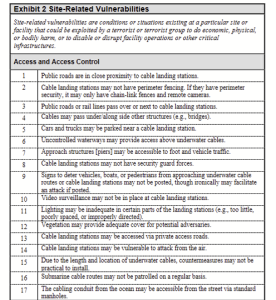

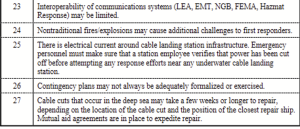
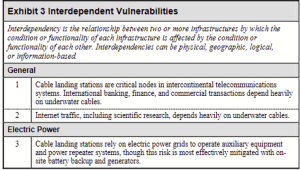
Vulnerabilities – Concentration of International Switching Facilities
Generally, submarine cables provide redundancy across a diverse mix of facilities internationally.
In some countries, the facilities handling submarine cables are concentrated in a single location or facility. The UK and Australia both concentrate their landing stations that handle international data traffic in a few key places. In the Philippines, this would be the landing stations at Davao and Batangas, with some redundancy at isolated facilities that handle 1-2 international cables on Luzon. In Taiwan, Fangshan, Pa Li, Tanshui, and Toucheng are connected almost everywhere in the Pacific and bring in all data outside of the Chinese mainland. In Japan, Shima and Maruyama bring in the majority of trans-Pacific traffic. In South Korea, Geoje and Busan bring in almost all of the traffic, with only two other isolated and limited landing stations. Others are Thailand: 4 sites, Cambodia: 1 site, Vietnam: 3 sites, Hong Kong: ~7 sites, but clustered in a few square miles, connecting almost everything in the Pacific.
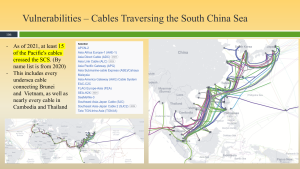
Vulnerabilities – Asia-America Gateway Cable System (AAG)
The AAG cable system (Asia-America Gateway) is the first trans-Pacific submarine cable system linking Southeast Asia directly with the USA It provides connectivity between Malaysia, Singapore, Thailand, Brunei Darussalam, Vietnam, Hong Kong SAR, the Philippines, Guam, Hawaii, and the US West Coast. It is the highest target for terrorists. The AAG cable system has significant advantages over the traditional trans-Pacific routes (via the North Pacific) as it avoids the area most prone to seismic activity off the Taiwan region, which has previously resulted in damage to undersea cables and network disruptions. The AAG submarine cable system was ready for service on November 10, 2009. It consists of:
Cable System: AAG, Asia-America Gateway (See Figure 2-22)
Cable Length:
20,000 Km (20,191 Km)
US Mainland – Hawaii: 4228 Km, three fiber pairs
Hawaii – Hong Kong: 10,728 Km, two fiber pairs
Hong Kong – Southeast Asia spurs: 5,235 Km, three fiber pairs
Initial Design Capacity: with 96*10G DWDM technology
US Mainland – Hawaii: 2.88 Tbps
Hawaii – Hong Kong: 1.92 Tbps,
Hong Kong – Southeast Asia: 2.88 Tbps
Ready for Service Date: November 10, 2009
Owner(s):
The AAG consortium consists of 19 parties, including:
AT&T, USA
AiTi, Brunei Darussalam
Telcotech, Cambodia
Reach, Hong Kong
Bharti, India
Telkom Indonesia, Indonesia
PT Indosat, Indonesia
Telekom Malaysia, Malaysia
BayanTel, Philippines
ETPI, Philippines
PLDT, Philippines
StarHub, Singapore
CAT Telecom, Thailand
Saigon Postal Corporation, Vietnam
Viettel, Vietnam
Vietnam Posts and Telecommunications Group, Vietnam
Telstra, Australia
Telecom New Zealand, New Zealand
British Telecom Global Network Services, UK
Source: (R.K…..Nichols, Johnson, & Diebold, 2024)
The Landing Points on the AAG represent serious vulnerabilities to global communications. AAG’s purview is shown in Figure 2-22. (Nichols, Diebold, & Johnson, Risk Analysis of submarine cables in the Western Pacific, 2024)
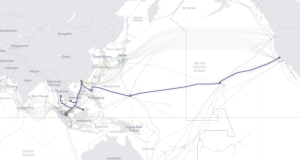
Other Landing point vulnerabilities are discussed in (R.K. Nichols, Johnson, & Diebold, 2024). They include Landing Point in Lantau Island, China (Near Hong Kong); Landing Point in Lantau Island, China; Landing Point in Chongming, China; Landing Point in Nanhui, China; and Landing Point in Hainan, China. The latter is a known Chinese UAS launch point for maritime surveillance
because of connections to the Philippines, Brunei, and Singapore, all of whom have coast guard interests in the SCS. (R.K. Nichols, Johnson, & Diebold, 2024)
Lantau Cable Landing Station, or Lantau CLS
South Lantau Cable Landing Station is located at Tong Fuk Beach in the south of Lantau Island, Hong Kong, about 6 miles away from the Hong Kong International Airport, which is located in the north of Lantau Island. The Lantau Cable Landing Station is now the terminal station for AAG, APCN, APCN-2, and FEA submarine cables.
The Lantau Cable Landing Station is the most crowded and important cable landing station in Hong Kong, as a hub for multiple intra-Asia, trans-Pacific, and Asia-Europe-Africa submarine cables.
There is another cable landing station quite close to the Lantau CLS, i.e., the Tong Fuk Cable Landing Station for the FNAL/RNAL cable system.
Station Name:
Lantau Cable Landing Station, or Lantau CLS
Station Owner: Reach
Available Backhaul Providers:
Reach, PCCW, Reliance, etc.
Submarine Cable Systems:
AAG
APCN
APCN-2
FEA (FLAG Europe-Asia)
COUNTERMEASURES
It is not the purpose of this chapter to discuss detailed countermeasures for actions in the U. S. SCS or for SCC. Much of this information is CLASSIFIED. The KSU Wildcat Author Team discusses OPEN-SOURCE information for multiple Attack / Defense Scenarios in other textbooks in its UAS/CUAS/UUV/Space/Marine series. Refer to (Nichols R. K., 2022); (Nichols R., Chapter 14 Maritime Cybersecurity, 2020); (Nichols R., Ryan Nichols Qualitative Information Risk Assessment, 2023); (Nichols, Diebold, & Johnson, Risk Analysis of submarine cables in the Western Pacific, 2024); (Nichols R. K., et al., 2021); (Nichols R. K., et al., 2020); and (R.K..Nichols, Johnson, & Diebold, 2024).
However, there are two NON-CLASSIFIED countermeasure schemes worth mentioning: 1) New Cable routes to avoid Chinese Landing points and 2) Guam, the big switch in the Pacific. Chapter 3 will consider the risk assessments associated with Guam Landing Station.
Countermeasures – New Cable Routes
Planning new cable routes that specifically avoid Hong Kong and the South China Sea
Echo, Apricot, and Bifrost are three examples of systems connecting the US, Guam, the Philippines, Indonesia, and Japan, projected for completion in the next two years. *Of note, none of these cables connect Hawaii (I-PACOM HQ) to the region.
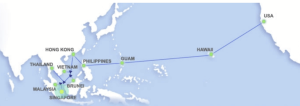
Countermeasures – Guam, The Big Switch in the Pacific
Guam hosts 16 cables that connect most of the Pacific. They have a large military footprint, and US regulations block Chinese influence. From a US standpoint, Guam is a focal point for controlling Chinese Navy movements and Theater surveillance and defense.
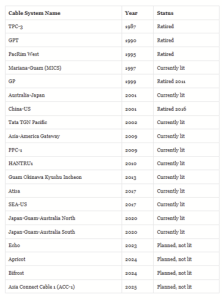
Conclusions / Discussion / Analysis
Overall, there are significant layers of redundancy in the undersea cable network and planned expansions that bypass the most significant Chinese and Russian threats within the 1st Island Chain. With this redundancy comes access. China has a state-owned interest in nearly every cable system and potential access to data at landing points that are non-US-controlled. It is likely they already have or could gain a data advantage over the US using just undersea cable access points. The South China Sea presents a significant issue for international data traffic, and the impact of an attack would be most impactful for Pacific Island nations, but not necessarily for US Operations. Risk analysis indicates that individual attacks on specific landing points or cables would present few issues. However, a few coordinated attacks on multiple cable systems in specific locations (i.e., Hawaii and Guam) may limit mission command of US Forces operating in the Pacific. Both China and Russia can do this. (CSIS, 2023) (More on Risk Assessments applied to Guam in Chapter 3.)
Taiwan is at great risk of being disrupted with only a few landing stations, easily accessible cables, and a determined enemy with the capability to conduct disruptive attacks.
Cyber-attacks would be difficult to employ and achieve little effect. Multiple redundancies and security features obstruct access to full networks, and an attack would need to be extraordinarily widespread to achieve a noticeable effect. A terrorist attack would have to attack multiple simultaneous targets to have an effect that is not covered in redundancy. Their limited presence in Mindanao and small groupings outside of the US make this very unlikely. BUT possible with the Chinese intentions, budgets, and support of PLAN.
References
aag-cable-system. (2023, February 13). Retrieved from https://www.submarinenetworks.com/: https://www.submarinenetworks.com/en/systems/trans-pacific/aag/aag-cable-system
arc-anglerfish-arc2-prod-copesa/public/Q6LSMZOASVBSTKBN5PTAREOEPU.jpg. (2024, February 2). Retrieved from https://www.latercera.com/: https://www.latercera.com/resizer/rIe5c-Yc9SfvgWMxhjNJqq5kUdo=/arc-anglerfish-arc2-prod-copesa/public/Q6LSMZOASVBSTKBN5PTAREOEPU.jpg
CIMSEC. (2023, February 1). leaning-on-the-big-switch-in-the-pacific-why-the-united-states-dominates-pacific-telecom-infrastructure/. Retrieved from https://cimsec.org//: https://cimsec.org/leaning-on-the-big-switch-in-the-pacific-why-the-united-states-dominates-pacific-telecom-infrastructure/
CSIS. (2023, February 8). securing-asias-subsea-network-us-interests-and-strategic-options. Retrieved from https://www.csis.org/: https://www.csis.org/analysis/securing-asias-subsea-network-us-interests-and-strategic-options
CSIS. (2025). ReConAsia_Asia_Subsea_2.jpg. Retrieved from https://csis-website-prod.s3.amazonaws.com/: https://csis-website-prod.s3.amazonaws.com/s3fs-public/ReConAsia_Asia_Subsea_2.jpg?Eb7LGnUwPZ6V0nsJUUSkjsEIb0o5KoLa
CSIS. (2025). ReConAsia_Asia_Subsea_4.jpg. Retrieved from https://csis-website-prod.s3.amazonaws.com/: https://csis-website-prod.s3.amazonaws.com/s3fs-public/ReConAsia_Asia_Subsea_4.jpg?YwlLFxjNkUMbBJoBTj60_kWM.HiivhlA
everything-known-about-losharik. (2019, July 19). Retrieved from https://www.rbth.com/: https://www.rbth.com/science-and-tech/330607-everything-known-about-losharik
FCC. (2025). submarine-cables. Retrieved from https://www.fcc.gov/: https://www.fcc.gov/submarine-cables
Forbes. (2023, February 14). https://www.forbes.com/sites/hisutton/2019/10/08/new-intelligence-on-russian-losharik-nuclear-submarine-accident/. Retrieved from https://www.forbes.com/sites/hisutton/2019/10/08/new-intelligence-on-russian-losharik-nuclear-submarine-accident/: https://www.forbes.com/sites/hisutton/2019/10/08/new-intelligence-on-russian-losharik-nuclear-submarine-accident/
hawaii.edu/news/. (2019, December 12). uh-system-rti-submarine-cable-jga/. Retrieved from https://www.hawaii.edu/news: https://www.hawaii.edu/news/2019/12/16/uh-system-rti-submarine-cable-jga/
Jamesstown Org: Publication: China Brief Volume: 21 Issue: 18. (2021, September 23). beijings-growing-influence-on-the-global-undersea-cable-network/. Retrieved from https://jamestown.org/: https://jamestown.org/program/beijings-growing-influence-on-the-global-undersea-cable-network/
Nichols, R. (2020). Chapter 14 Maritime Cybersecurity. In R. K. Nichols, et.al, Unmanned Vehicle Systems & Operations on Air, Sea, Land. Manhattan, KS: NPP Press: https://www.newprairiepress.org/ebooks/35/.
Nichols, R. (2023). Ryan Nichols Qualitative Information Risk Assessment. Class Presentation. KSU.
Nichols, R. K. (2022). DRONE DELIVERY OF CBNRECy – DEW WEAPONS Emerging Threats of Mini-Weapons of Mass Destruction and Disruption ( WMDD). Manhattan, KS: https://newprairiepress.org/ebooks/46/.
Nichols, R. K., Mumm, H. C., Lonstein, W. D., Ryan, J. J., Carter, C. M., Hood, J.-P., . . . and Jackson, M. J. (2020). Unmanned Vehicle Systems & Operations on Air, Sea, Land. Retrieved from https://newprairiepress.org/ebooks/35/: https://newprairiepress.org/ebooks/35/
Nichols, R. K., Mumm, H. C., Lonstein, W., Sincavage, S., Carter, C. M., Hood, J.-P., . . . and Shields, B. (2021). Disruptive Technologies with Applications in Airline, Marine, and Defense Industries (2021). Retrieved from https://newprairiepress.org/ebooks/38/: https://newprairiepress.org/ebooks/38/
Nichols, R. K., Sincavage, S., Mumm, H., Lonstein, W., Carter, C., Hood, J. P., . . . and Harding, T. “(2022). Drone Delivery of CBNRECy DEW Weapons: Emerging Threats of Mini-Weapons. Retrieved from https://newprairiepress.org/ebooks/46/: https://newprairiepress.org/ebooks/46/
Nichols, R., Diebold, C., & Johnson, P. (2022, 10 18). Suas/UAS Cyber Terror Implications & Cyber-Navigation Threats & CHINESE UAS INTELLIGENCE CAPABILITIES & Impending Invasion Of TAIWAN. C2SR Proceedings KEYNOTE. ONLINE, ND, USA: UND & KSU .
Nichols, R., Diebold, M. C., & Johnson, &. P. (2024). Risk Analysis of submarine cables in the Western Pacific. Manhattan, KS: KSU.
PBS. (2021). Trans-Pacific Undersea cables. Retrieved from https://pbs.twimg.com/: https://pbs.twimg.com/media/Fir8fudVEAAnpGh?format=jpg&name=large
R.K..Nichols, Johnson, P., & Diebold, M. C. (2024). Risk Analysis in many forms: An analysis of submarine cables in the Western Pacific. Manhattan: KSU.
Russian Losharik. (2020, August 16). Retrieved from https://www.iefimerida.gr/: https://www.iefimerida.gr/sites/default/files/inline-images/losharik.jpg
SCMP. (2021, July 30). Chinese Ownership in Cables. Retrieved from https://cdn.i-scmp.com/sites/: https://cdn.i-scmp.com/sites/default/files/d8/images/methode/2019/12/14/a85e40d2-1cd3-11ea-8971-922fdc94075f_image_hires_161048.jpg
Sun Corp. (2021, September 13). russian-spy-ship-spotted-english-channel. Retrieved from https://www.the-sun.com/: https://www.the-sun.com/news/3650555/russian-spy-ship-spotted-english-channel
vietnamnews. (2024, February 14). https://image.vietnamnews.vn/uploadvnnews/Article/2019/9/9/37010_aagcable.dib. Retrieved from https://image.vietnamnews.vn/: https://image.vietnamnews.vn/uploadvnnews/Article/2019/9/9/37010_aagcable.dib
WIKI. (2018, June 18). Yantar_research_vessel_04.jpg. Retrieved from https://upload.wikimedia.org/: https://upload.wikimedia.org/wikipedia/commons/2/29/Yantar_research_vessel_04.jpg
WIKI. (2022). Russian_research_vessel_Yantar. Retrieved from https://en.wikipedia.org: https://en.wikipedia.org/w/index.php?title=Russian_research_vessel_Yantar&oldid=1113227791
WIKI. (2025). Submarine_communications_cable. Retrieved from https://en.wikipedia.org/wiki/: https://en.wikipedia.org/wiki/Submarine_communications_cable
